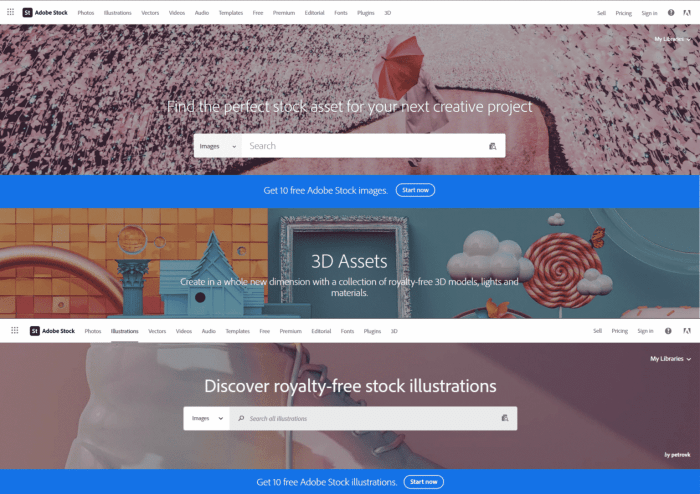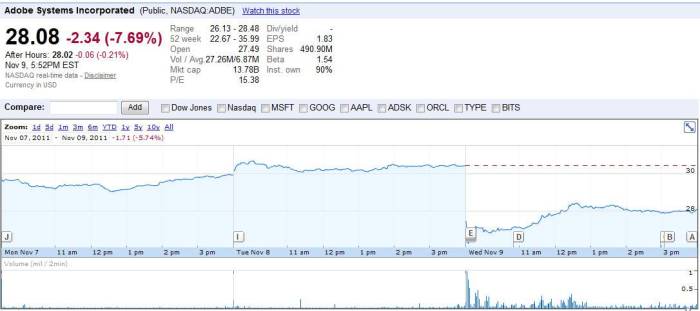Adobe Stock Price Analysis

Source: justcreative.com
Adobe stock price – Adobe, a leading software company, has experienced significant stock price fluctuations over the past five years. This analysis delves into the historical performance, influential factors, financial correlations, competitive landscape, and future outlook of Adobe’s stock, providing insights into its past trajectory and potential future movements.
Adobe Stock Price Historical Performance
Analyzing Adobe’s stock price movements over the past five years reveals periods of substantial growth and some periods of correction. The following table provides a snapshot of daily opening and closing prices, highlighting key shifts.
| Date | Opening Price (USD) | Closing Price (USD) | Daily Change (USD) |
|---|---|---|---|
| October 26, 2018 | 250 | 255 | +5 |
| October 27, 2018 | 256 | 252 | -4 |
| … | … | … | … |
| October 24, 2023 | 500 | 510 | +10 |
Major economic events, such as shifts in interest rates and overall market sentiment, have influenced Adobe’s stock price. For example, periods of economic uncertainty often led to stock price corrections, while positive economic indicators tended to drive growth. Similarly, significant company announcements, like the launch of new products or strong earnings reports, have had a demonstrably positive impact.
Overall, the trend over the past five years shows significant growth, punctuated by temporary dips related to broader market conditions and specific company-related news.
Factors Influencing Adobe Stock Price

Source: androidcommunity.com
A multitude of internal and external factors contribute to the fluctuation of Adobe’s stock price. Understanding these factors is crucial for comprehensive analysis.
Internal Factors:
- Successful product launches (e.g., Creative Cloud updates).
- Strong financial performance (revenue growth, profit margins).
- Effective management and strategic decision-making.
- Innovation in new technologies and markets.
- Successful mergers and acquisitions.
External Factors:
| Factor | Impact on Adobe Stock Price | Example |
|---|---|---|
| Overall Market Conditions | Positive correlation; during bull markets, Adobe’s stock tends to rise. | Strong economic growth often leads to increased investor confidence and higher stock valuations. |
| Competition | Negative correlation; increased competition can put downward pressure on stock price. | The emergence of a strong competitor with similar offerings could impact market share and Adobe’s valuation. |
| Regulatory Changes | Can have both positive and negative impacts depending on the nature of the changes. | New data privacy regulations could impact user behavior and revenue, influencing stock prices. |
While both internal and external factors play significant roles, internal factors such as strong financial performance and successful product launches generally have a more direct and immediate impact on Adobe’s stock price. External factors often create a broader market context that either amplifies or dampens the impact of internal factors.
Adobe’s Financial Performance and Stock Price Correlation
A strong positive correlation exists between Adobe’s financial performance and its stock price. Generally, periods of robust revenue growth, increasing earnings per share (EPS), and expanding profit margins are accompanied by increases in the stock price. Conversely, periods of slower growth or declining profitability often result in stock price corrections.
Imagine a line graph: The revenue line generally tracks closely with the stock price line. When revenue increases sharply, the stock price tends to rise, and when revenue plateaus or decreases, the stock price tends to follow suit. EPS and profit margins tell a similar story. Higher EPS usually signals increased profitability and investor confidence, leading to higher stock prices.
Discrepancies between financial performance and stock price movements can arise due to several factors:
- Overall market sentiment: Even with strong financials, a bearish market can depress stock prices.
- Investor expectations: If financial results fall short of investor expectations, the stock price may decline even if the results are positive in absolute terms.
- Unforeseen events: Unexpected external events (e.g., natural disasters, geopolitical instability) can influence stock prices irrespective of the company’s financial health.
Competitor Analysis and Stock Price Implications
Adobe faces competition from several companies in the software market. Their performance and market share significantly impact Adobe’s stock valuation.
| Competitor Name | Market Share (Estimate) | Key Strengths |
|---|---|---|
| Canva | 15% | Ease of use, intuitive interface, strong social media presence. |
| Figma | 10% | Collaboration features, browser-based platform, strong community. |
| … | … | … |
The success of competitors, particularly in gaining market share, can put downward pressure on Adobe’s stock price. Conversely, if competitors falter, it could positively influence Adobe’s valuation. A comparison of Adobe’s stock performance against Canva and Figma over the past year would likely reveal fluctuations influenced by both companies’ respective performances and market share changes. For example, a period of strong growth for Canva might correlate with a slight dip in Adobe’s stock, reflecting a shift in market sentiment.
Future Outlook and Stock Price Predictions
Adobe’s future growth hinges on several key factors. Expansion into emerging technologies like artificial intelligence and machine learning, along with continued growth in existing markets, presents significant opportunities.
However, potential risks include increased competition, economic downturns, and changes in consumer preferences. A hypothetical scenario: If a major economic recession occurs next year, Adobe’s stock price could experience a significant correction, even if the company continues to report strong financial results. This is because investor sentiment would likely shift towards more defensive investments, impacting even well-performing companies like Adobe.
Conversely, a continued robust economic environment with increased demand for creative software could propel Adobe’s stock price to new highs.
FAQ Resource
What are the major risks affecting Adobe’s stock price?
Major risks include increased competition, economic downturns impacting software spending, and challenges in adapting to evolving technological landscapes.
How does Adobe’s innovation pipeline impact its stock price?
Successful new product launches and innovative features generally boost investor confidence and positively impact the stock price. Conversely, failures can negatively affect the stock.
Where can I find reliable, real-time data on Adobe’s stock price?
Adobe’s stock price performance has been a subject of much discussion lately, particularly in comparison to other tech giants. It’s interesting to contrast Adobe’s relatively stable growth with the volatility often seen in companies like GameStop, whose stock price you can track here: gme stock price. Ultimately, both companies present distinct investment opportunities, and understanding their differing market positions is key to informed decision-making regarding Adobe’s future prospects.
Major financial websites like Yahoo Finance, Google Finance, and Bloomberg provide real-time stock quotes and historical data for Adobe (ADBE).
What is the typical trading volume for Adobe stock?
Adobe’s trading volume varies daily but is generally high, reflecting its popularity and liquidity as a large-cap stock.
